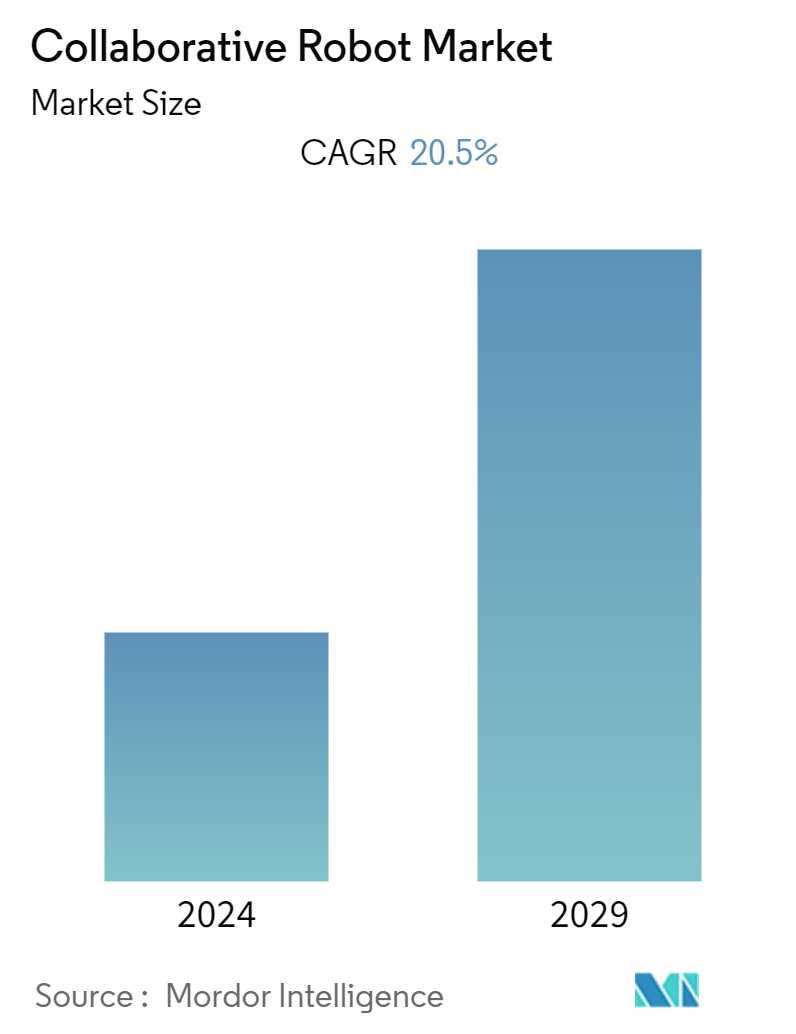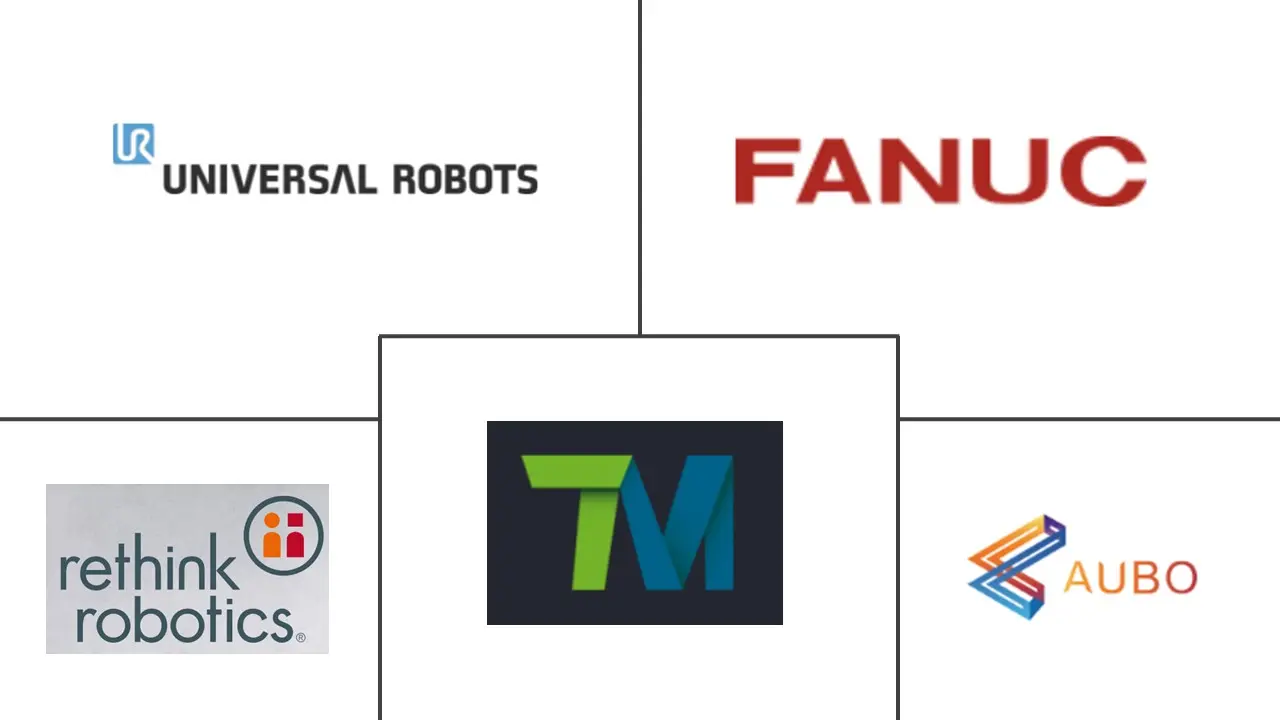Market Size of Collaborative Robot Industry

| Study Period | 2019 - 2029 |
| Base Year For Estimation | 2023 |
| CAGR (2024 - 2029) | 20.50 % |
| Fastest Growing Market | Asia Pacific |
| Largest Market | Asia Pacific |
| Market Concentration | Low |
Major Players
*Disclaimer: Major Players sorted in no particular order |
Collaborative Robots Market Analysis
The Collaborative Robot Market is expected to register a CAGR of 20.5% during the forecast period.
As robots work even more closely with humans, they must respond to the users and adapt their behaviors. Over the next few years, researchers are expected to recognize basic human behaviors and adapt these robots' actions to respond to them. Over the next few years, this would develop into much more advanced programs that could adapt to the needs of complex tasks.
- Robust growth in advanced technologies, such as digital twins, virtual reality (VR), augmented reality (AR), and developments in offline programming and simulation software, enables companies to optimize robot performance. It also helps them develop and test different configurations to find the best solution for their requirements.
- Edge computing is an interesting new approach to network architecture that helps businesses break beyond the limitations of traditional cloud-based networks. As innovative machines like autonomous robots and medical sensors become more common, edge computing will significantly impact society.
- Rapid advancements in artificial intelligence (AI) enable them to execute tasks accurately in a continuously changing environment. AI-integrated cobots help manufacturers in various applications that make operations run efficiently, smoothly, and productively. AI-driven cobots recognize the orientation and presence of materials, perform testing and inspection, dynamically pick and place tasks, read results post-inspection, and derive decisions accordingly.
- Longer training and onboarding, increasing benefits and compensation rates, and labor shortages are significant factors driving the deployment. More and more warehousing, distribution, and fulfillment facilities are investing in automated solutions. As technology improves and the applications become broader and more flexible, robotics is being adopted by a more significant number of manufacturing operations across regions.
- The robots integrated with advanced technologies cost high as compared to traditional robots. The costs of robotic systems are associated with robust hardware and efficient software. Automation equipment involves the usage of advanced automation technologies that require high capital investment. For instance, an automated system may cost millions of Dollars for design, fabrication, and installation.
Collaborative Robots Industry Segmentation
Collaborative robots are designed to work with humans and are built with safety features such as integrated sensors, passive compliance, and overcurrent detection. The integrated sensors feel external forces, and if the force is too high, they halt the robot's movement.
The Collaborative Robot Market is segmented by payload (less than 5 kg, 5-9 kg, 10-20 kg, and more than 20 kg), end-user industry (electronics, automotive, manufacturing, food and beverage, chemicals and pharmaceutical), application (material handling, pick and place, assembly, palletizing & de-palletizing), and geography (North America (United States, Canada), Europe (United Kingdom, Germany, France, Rest of Europe ), Asia Pacific (China, India, Japan, Rest of Asia Pacific) Latin America (Brazil, Mexico, Rest of Latin America), and Middle East and Africa (United Arab Emirates, Saudi Arabia, Rest of Middle East and Africa)). The market sizes and forecasts are provided in terms of value in USD for all the above segments.
| By Payload | |
| Less Than 5Kg | |
| 5-9 Kg | |
| 10-20 Kg | |
| More Than 20 KG |
| By End-user Industry | |
| Electronics | |
| Automotive | |
| Manufacturing | |
| Food and Beverage | |
| Chemicals and Pharmaceutical | |
| Other End-user Industries |
| By Application | |
| Material Handling | |
| Pick and Place | |
| Assembly | |
| Palletizing and De-palletizing | |
| Other Applications |
| By Geography | ||||||
| ||||||
| ||||||
| ||||||
| ||||||
|
Collaborative Robot Market Size Summary
The collaborative robots market is poised for substantial growth, driven by advancements in technologies such as artificial intelligence, digital twins, and edge computing. These innovations enable robots to work more closely with humans, adapting to complex tasks and enhancing operational efficiency across various industries. The integration of AI allows cobots to perform tasks with high precision in dynamic environments, making them invaluable in sectors like manufacturing and automotive. The automotive industry, in particular, is witnessing a surge in the adoption of collaborative robots, as they offer cost-effective solutions and improved production outputs. This trend is supported by significant investments from major automakers, who are increasingly incorporating cobots into their assembly lines to streamline processes and enhance productivity.
The Asia Pacific region is experiencing rapid expansion in the collaborative robot market, with China leading the charge due to its focus on industrial automation and technological innovation. The Chinese government's strategic initiatives aim to position the country as a global leader in robot technology, further fueling market growth. Meanwhile, India and Japan are also making strides in adopting collaborative robots, driven by initiatives to digitize industries and address labor shortages. The market is highly fragmented, with key players like Universal Robots, Fanuc Corp., and TechMan Robot Inc. leveraging partnerships and technological advancements to maintain a competitive edge. These developments underscore the growing importance of collaborative robots in achieving efficient and intelligent manufacturing environments worldwide.
Collaborative Robot Market Size - Table of Contents
-
1. MARKET INSIGHTS
-
1.1 Market Overview
-
1.2 Industry Attractiveness - Porter's Five Forces Analysis
-
1.2.1 Bargaining Power of Suppliers
-
1.2.2 Bargaining Power of Buyers
-
1.2.3 Threat of New Entrants
-
1.2.4 Intensity of Competitive Rivalry
-
1.2.5 Threat of Substitute Products
-
-
1.3 Industry Value Chain Analysis
-
1.4 Impact of COVID-19 on the Market
-
1.5 Pricing Analysis
-
-
2. MARKET SEGMENTATION
-
2.1 By Payload
-
2.1.1 Less Than 5Kg
-
2.1.2 5-9 Kg
-
2.1.3 10-20 Kg
-
2.1.4 More Than 20 KG
-
-
2.2 By End-user Industry
-
2.2.1 Electronics
-
2.2.2 Automotive
-
2.2.3 Manufacturing
-
2.2.4 Food and Beverage
-
2.2.5 Chemicals and Pharmaceutical
-
2.2.6 Other End-user Industries
-
-
2.3 By Application
-
2.3.1 Material Handling
-
2.3.2 Pick and Place
-
2.3.3 Assembly
-
2.3.4 Palletizing and De-palletizing
-
2.3.5 Other Applications
-
-
2.4 By Geography
-
2.4.1 North America
-
2.4.1.1 United States
-
2.4.1.2 Canada
-
-
2.4.2 Europe
-
2.4.2.1 United Kingdom
-
2.4.2.2 Germany
-
2.4.2.3 France
-
-
2.4.3 Asia
-
2.4.3.1 China
-
2.4.3.2 India
-
2.4.3.3 Japan
-
2.4.3.4 Australia and New Zealand
-
-
2.4.4 Latin America
-
2.4.4.1 Brazil
-
2.4.4.2 Mexico
-
-
2.4.5 Middle East and Africa
-
2.4.5.1 United Arab Emirates
-
2.4.5.2 Saudi Arabia
-
-
-
Collaborative Robot Market Size FAQs
What is the current Collaborative Robot Market size?
The Collaborative Robot Market is projected to register a CAGR of 20.5% during the forecast period (2024-2029)
Who are the key players in Collaborative Robot Market?
Universal Robots AS, Fanuc Corp., TechMan Robot Inc., Rethink Robotics GmbH and AUBO Robotics USA are the major companies operating in the Collaborative Robot Market.

